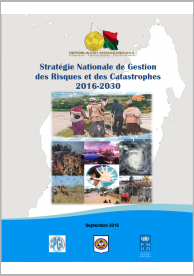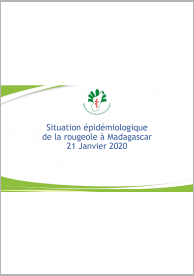It is estimated that earthquakes, floods and tropical cyclones cause average annual direct losses of approximately $100 million in Madagascar (WB, 2016). Extreme natural hazards in the country also include droughts, dunes advances, landslides and wildfires (UNISDR, 2019). Madagascar’s government is aware of the country’s vulnerability to climate extreme events and committed to addressing it through resilience strengthening and an inclusive and multisectoral approach (UNISDR, 2019).
The National Council for Risk and Disaster Management (Bureau National de Gestion des Risques et des Catastrophes) is the DRR and management responsible institution at the national level. The DRR and management Madagascar’s institutional framework also includes the National Council for Risk and Disaster Management (Conseil National de Gestion des Risques et Catastrophes), which oversees planning, supervising and evaluating the implementation of the National Strategy for Risk and Disaster Management.
The legal framework for disaster risk reduction and management in Madagascar is set by the National Disaster Risk Management Strategy 2016-2030. This instrument is a guideline to the decision-making of Disaster Risk Management. Other guiding instruments on DRR include, for instance, the National Risk and Disaster Management Strategy 2016-2020; and the National Risk and Disaster Management Policy (2015).
More recently, the country has implemented several financial protection mechanisms, such as the drought insurance system and the national disaster fund (UNISDR, 2019).
- WB (2016). Disaster Risk Profile. Washington: World Bank.
- UNISDR (2019). Global Platform for Disaster Risk Reduction - Speeches and Statements. Retrieved from:
https://www.unisdr.org/conference/2019/globalplatform/programme/offic…
Madagascar is a large island located in the Indian Ocean, and has a tropical climate, rainy along the east coast, arid in the south-west, and temperate in the mountains. In inland areas, mountain ranges mitigate the climate, while rainfall varies depending on slope exposure.
In the whole country, there's a rainy season from November to March, which, however, produces little effects in the southwest, which is therefore arid. On the other hand, in most of the country, there is a dry season from April to October (or from May to September in the north), except on the east coast, where it rains all year round. As is typical of tropical areas, the rains usually occur in the form of thunderstorms, especially in the afternoon, so there's no shortage of sunshine even in the wettest months, at least in the morning hours.
In the cool period, from mid-May to September, but sometimes also in October, cool air masses from the south-west can affect the country, bringing a bit of cool weather at night, especially in the center-south, and even cold in inland areas.

Regional Platform / DRR Contact Point
-
Government of MadagascarOrganization type:Location
Risk reduction Policies, Plans & Strategies
Policies, plans and official statements on disaster risk, climate adaptation and resilience.

|
Timeline-Driven Information Flow SOP
Describes Tsunami Event Response: When, What, Who, How, and To Whom. |

|
National Risk and Disaster Management Strategy 2016-2030
The National Strategy for Risk and Disaster Management (SNGRC in french) is a strategic instrument with national scope, applicable during the period 2016-2030, which has for vision a nation resilient to shocks, protected from all damage, in its social and cultural dimension, economic and environm |

|
National Climate Change Policy
This document aims to strengthen the fight against climate change in the country, and in this sense, serves as a reference for the actions to be undertaken. It also gives the main directions of the fight against climate change focused on implementation strategies. |
Documents & Publications
Disaster risk reduction and resilience publications, reports, research papers and case studies.

|
Epidemiological situation of the measles in Madagascar, January 21, 2020
An analysis of the epidemiological situation of the measles in Madagascar in January 2020. |

|
Epidemiological situation of the plague in Madagascar, from August 5, 2019 to January 9, 2020
An analysis of the plague in Madagascar between the period from August 2019 to January 2020. |

|
IPC Analysis of acute food insecurity (July 2019- June 2020)
A food insecurity analysis for the period between July 2019 and June 2020. |
Disaster Data & Statistics
Reports on disaster statistics, country profiles and additional resources on collecting disaster loss data.

|
INFORM Country Risk Profile - Madagascar
Index for Risk Management. |

|
Disaster Risk Profile - Madagascar
This disaster risk profile for Madagascar seeks to provide a basis for the future implementation of disaster risk financing through the improved understanding of disaster risks. |

